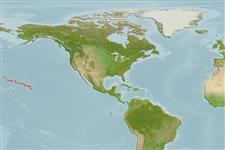Environment: milieu / climate zone / depth range / distribution range
Ecologia
marinhas bentopelágico; intervalo de profundidade 5 - 380 m (Ref. 5222). Tropical; 30°N - 11°N, 179°W - 153°W (Ref. 5222)
Eastern Central Pacific: known only from the Hawaiian Islands and Johnston Island.
Tamanho / Peso / Idade
Maturity: Lm ? range ? - ? cm
Max length : 122 cm TL macho/indeterminado; (Ref. 4887); peso máx. Publicado: 22.7 kg (Ref. 4887)
Espinhos dorsais (total): 11; Raios dorsais moles (total): 14-15; Espinhos anais 3; Raios anais moles: 9. Distinguished by the following characteristics: juveniles greyish brown to dark brown body color with 8 vertical series of white spots on body; adults dark brown with less distinct vertical series of white spots and obscured by numerous additional pale spots and blotches of variable size; fins mostly unspotted; depth of body contained 2.3-2.7 times in SL, width 2.0-2.5 times in depth; head length 2.3-2.5 times in SL; convex interorbital area, width subequal to eye diameter for fish 10-20cm SL; subangular preopercle, 3-5 enlarged serrae at angle; fleshy ventral edge of preopercle, without serrae; smooth edge of interopercle and subopercle or with a few serrae; convex upper edge of operculum; ovate and enlarged posterior nostrils of adults, larger than anterior nostrils (Ref. 89707).
Occurs in deep waters (Ref. 7364). Benthic and benthopelagic (Ref. 58302). Feeds mainly on fish and crustaceans (Ref. 89707). A good fish to eat, fleshy, eaten any way except raw (Ref. 7364). Minimum depth from Ref. 122680.
Life cycle and mating behavior
Maturidade | Reprodução | Desova | Ovos | Fecundidade | Larvas
Craig, M.T. and P.A. Hastings, 2007. A molecular phylogeny of the groupers of the subfamily Epinephelinae (Serranidae) with revised classification of the epinephelini. Ichthyol. Res. 54:1-17. (Ref. 83414)
Categoria na Lista Vermelha da IUCN (Ref. 130435)
Ameaça para o homem
Harmless
Utilização humana
Pescarias: espécies comerciais; peixe desportivo: sim; Aquário: Espécies comerciais
Mais informação
Nomes comunsSinónimosMetabolismoPredadoresEcotoxicologiaReproduçãoMaturidadeDesovaAgregação para desovaFecundidadeOvosDesenvolvimento dos ovos
ReferênciasAquaculturaPerfil para aquaculturaEstirpesGenéticaElectrophoresesHereditariedadeDoençasProcessamentoNutrientsMass conversion
ColaboradoresFotografiasStamps, Coins Misc.SonsCiguateraVelocidadeTipo de nataçãoÁrea branquialOutras referênciasCérebrosVisão
Ferramentas
Relatórios especiais
Descarregue XML
Fontes da internet
Estimates based on models
Preferred temperature (Ref.
123201): 9.3 - 15.3, mean 15.1 °C (based on 3 cells).
Phylogenetic diversity index (Ref.
82804): PD
50 = 0.5001 [Uniqueness, from 0.5 = low to 2.0 = high].
Bayesian length-weight: a=0.01445 (0.00826 - 0.02530), b=3.05 (2.90 - 3.20), in cm total length, based on LWR estimates for this species & Genus-body shape (Ref.
93245).
Nível Trófico (Ref.
69278): 4.0 ±0.67 se; based on food items.
Resiliência (Ref.
120179): Baixo, tempo mínimo de duplicação da população 4,5 - 14 anos (Preliminary K or Fecundity.).
Fishing Vulnerability (Ref.
59153): High to very high vulnerability (70 of 100).
Nutrients (Ref.
124155): Calcium = 38.4 [18.1, 76.4] mg/100g; Iron = 0.587 [0.297, 1.119] mg/100g; Protein = 17.3 [15.5, 19.1] %; Omega3 = 0.234 [0.132, 0.418] g/100g; Selenium = 108 [53, 231] μg/100g; VitaminA = 22.3 [7.4, 74.3] μg/100g; Zinc = 0.837 [0.566, 1.273] mg/100g (wet weight);
